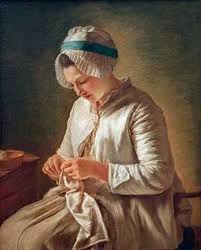The Farmer’s Daughter was first exhibited in 1887 at the Paris Salon and than in 1889 at the Exposition Universelle.
It is an oil painting that takes in and absorbs the viewer with the joys and pleasures of lifes simple things. The painting tells a story.
A young woman enjoying the simple task of feeding the chickens on a perfect sunny day.
The chickens gather around her as she lets the golden grain in her fingers scatter amongst them giving them food, pleasure, and joy!
Monthly Archives: March 2013
19th Century Female Artist Elizabeth Jane Gardner Bouguereau
Leave a commentA lot of work and much acclaim has been given to the rare female artists, the old masters, from previous centuries such as Elizabeth Vigee-Le Brun and painters like Mary Cassatt from the impressionist movement onwards
19th Century Classical Female Artists such as Elizabeth Jane Gardner Bouguereau have almost been forgotton.
Elizabeth Jane Gardner Bouguereau (1837-1922) was accused of copying or closely resembling her husband William Bouguereau style of painting. Elizabeth’s reply to this was “I know I am criticized for not more boldy asserting my individuality, but I would rather be known as the best imitator of Bouguereau than nobody!”
Although Elizabeth has been accussed of painting that closely resembles her husbands technique she has been accredited for her many stunning artworks that express her own unique voice and this gives her artwork a degree of separation.
18th Century Great Impressionist Master Edgar Degas
Leave a commentEdgar Degas (1834-1917) born in Paris, France. His father was a banker and his mother from New Orleans, America. Degas’s mother, Celestine was an amateur opera singer and his father often invited musicians to perform at their home. Degas had the gift of drawing and painting from an early age. His father, Auguste a knowledgeable art critic encouraged Edgar to pursue his talent. Degas was permitted to copy works of the great masters at the Louvre, Paris. He produced copied works from Raphael to the more contemporary painters such as Ingres and Delacroix. After a year studying at Ecole Des Beaux-Art in Paris, 1855 Degas left and began his 3 year journey through Italy painting copies from the works of the Great Renaissance Painters, Michelangelo and Da Vinci.
In 1859 he returned to Paris and began to paint family portraits and historical scenes. Degas used the Traditional approach. Degas submitted these works to a group of artists and teachers (the Salon) who presided over public exhibitions. The reaction to his works was one of indifference. The Salon had a rigid and conventional approach to beauty and proper form.
Degas in 1862 met Edouard Manet at the Louvre. They became friendly and Degas shared Manet’s belief that artists should turn to the modernist’s technique and subject matter.
Degas became a well known figure of the avant-garde artists group including Manet, Renoir, Monet and Sisley. These artist gathered at the Cafe Guerbois discussing ways in which they could approach and ingage with the modern world.
18th Century Female Artist Francoise Duparc
Leave a commentDuparc (1726-1778) was born in Spain. Her mother was Spanish and her father French.
Her father was a professional sculptor, and it is thought that Francoise and her sister were trained by their father to follow his artistic ability.
Francoise returned to France and became a professional painter. Francoise became influenced by the Dutch who painted everyday life activities. Her paintings are of women performing activities such as sewing and other household chores.
Duparc became elected in 1777 to the Academy of Marseilles. This was a great achievement for Duparc. She is an inspiration for women artists.



